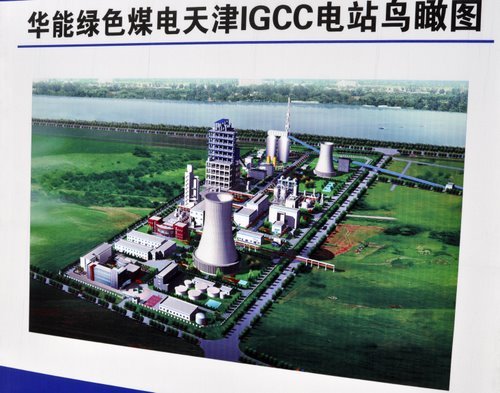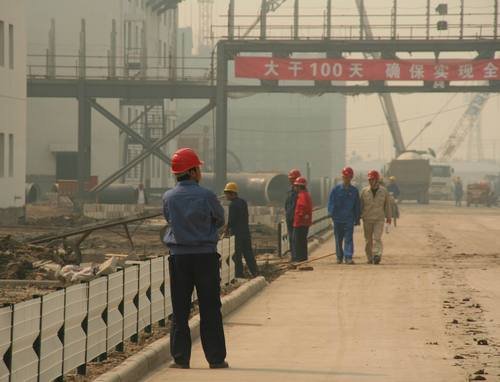Last week in Tianjin, NRDC's team got a first-hand look at China's ambitious investments in advanced coal technology. The GreenGen project, located in Tianjin's Binhai New Area, will be China's first commercial-scale integrated gasification combined cycle (IGCC) power plant. And when all three phases are completed, GreenGen will be one of the world's largest commercial-scale demonstrations of carbon capture and sequestration (CCS) technology. This is yet another reminder that China is not waiting for others to pioneer low-carbon technologies but is moving rapidly to develop many of them with its own resources.

 When the first phase of the 250MW IGCC facility is completed at the end of next year, small-scale CCS will be performed in a testing facility. A major milestone in this phase was reached not long after our visit: the primary gasifier for extracting synthetic gas (syngas) from coal was successfully installed. In the second phase, GreenGen plans to build a commercial-scale CCS system connected with its next IGCC phase at 450 MW. The facility will be a convenient platform on which to experiment and develop new, more efficient technologies including polygeneration, hydrogen gas turbines, and fuel cells. The final phase will reach max capacity at 650MW.
When the first phase of the 250MW IGCC facility is completed at the end of next year, small-scale CCS will be performed in a testing facility. A major milestone in this phase was reached not long after our visit: the primary gasifier for extracting synthetic gas (syngas) from coal was successfully installed. In the second phase, GreenGen plans to build a commercial-scale CCS system connected with its next IGCC phase at 450 MW. The facility will be a convenient platform on which to experiment and develop new, more efficient technologies including polygeneration, hydrogen gas turbines, and fuel cells. The final phase will reach max capacity at 650MW.
This $1 billion project is a joint effort of seven Chinese state-owned companies led by China Huaneng (China's largest electric utility). U.S. coal magnate Peabody Energy has a 6% share in the project. Therefore, GreenGen is basically receiving the full backing of the Chinese government. In addition, China's Ministry of Science and Technology is providing some funding for R&D and the Asian Development Bank has offered a large grant.
Except for the gas turbine to be supplied by Siemens, all the components are sourced domestically, including the crucial gasifier technology which was developed by Huaneng's Thermal Power Research Institute (TPRI). In addition to tapping the domestic market, TPRI is also expanding overseas. It is licensing its technology to U.S.-based Future Fuels for use in a 270MW IGCC/CCS plant in Good Springs, PA.
A short 40-minute drive from Tianjin's city center, the project is strategically located near the Dagang oil fields, allowing for sequestering carbon emissions in under-performing or depleted oil wells in order to improve the output of the wells. Known as enhanced oil recovery (EOR), this method of carbon sequestration provides near-term, economical CCS opportunities in China.
The construction site was impressive. GreenGen received approval from China's National Development and Reform Commission (NDRC) to begin design in May 2008, with construction beginning in May 2009, and it is already half-way done with its first phase. We visited the site in mid-day and saw some 2,000 workers and engineers busy working. In fact, workers are on site around the clock, sharing three eight-hour shifts a day.
Jiang Kejun, director of research for NDRC's Energy Research Institute, said at a convening of coal experts on the sidelines of the Tianjin climate change conference that China plans to build 20 more such gasification and CCS power plants if GreenGen is successful.
While we always emphasize energy efficiency and renewable energy sources as the first priorities in addressing rising GHG emissions, we also recognize China's continued dependence on coal as a fact. NRDC's China Program has been promoting energy efficiency policies and tools for China's power sector and is assessing ways to expand China's renewable energy resources. We applaud China's determination to phase out small, inefficient coal plants and gear up for a low-carbon future (see our most recent China factsheet).
Huaneng already operates two post-combustion carbon capture facilities – Shidongkou in Shanghai and Gaobeidian in Beijing – but the GreenGen project will use pre-combustion carbon capture, where carbon dioxide is captured from the syngas stream coming out of the gasifier. Syngas has higher concentrations of CO2 compared to flue gas from a regular coal-fired power plant, thereby reducing capture costs.
Advanced coal technologies and CCS are a critical investment for China as it seeks to reduce its carbon intensity by 40-45% by 2020. What we saw on the ground is a promising sign that China is seriously tackling the twin challenges of meeting the energy needs of its fast-growing economy while still addressing dangerous global warming pollution.
We look forward to hearing further progress from China on its efforts to reduce carbon emissions.
(This post was co-written with Michael Davidson and Adam Scherr.)


